A Coaching Model Created by Stefan Lachmann
(Learn Coaching, GERMANY)
Keep the balance in life!
1 The background and scope
Coaching literature provides a tremendous amount of categorisations on the so called ‘areas of life’ of a human being. The idea is generally the same, i.e. to cluster the client’s goals and to keep focus on a specific topic or niche during the coaching sessions.
The Mind Map in Figure 1 shows an example of four clusters by popular coaches.
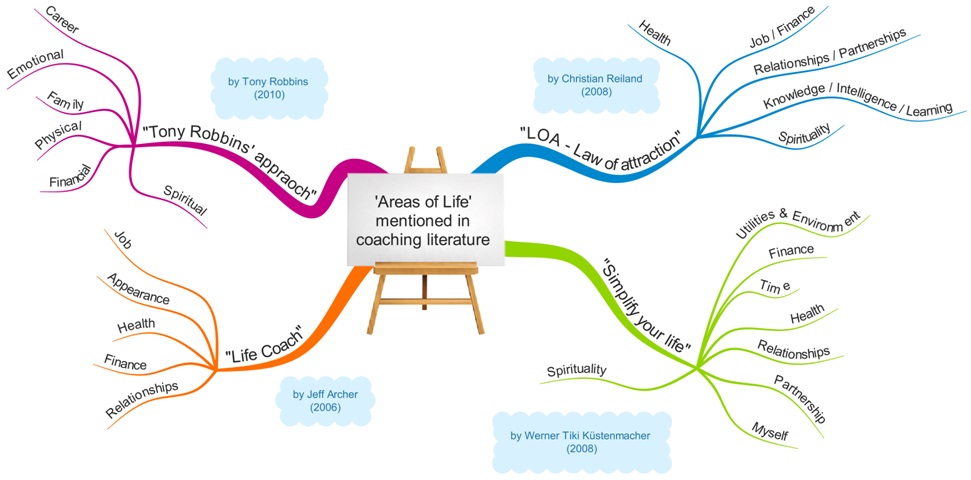 Figure 1: Areas of life mentioned in coaching literature
Figure 1: Areas of life mentioned in coaching literature
The Life-Equilibrium Model (LEM) follows a similar approach. It describes areas of life to provide orientation for the coach and client during the coaching session. Nonetheless, the coaching model goes one step further: The Life-Equilibrium Model itself follows the goal to visualize the degree of the client’s balance between the areas of life – and doing this constantly during his or her entire life.
Rather than starting each coaching session from the very beginning, the Life-Equilibrium Model supports identifying drawbacks and / or imbalances consciously and to tackle those through a coaching on the client’s own initiative. Hence, the Life-Equilibrium Model is a constant companion on the journey of life; allowing self-reflection with the aim to keep balance in life.
2 The purpose
The purpose of the Life-Equilibrium Model is to provide a kind of ‘map’ for the client to visualize potentially complex coaching topics in regards to the mechanics of life, the areas of life and the individual elements of life in a simple way.
In addition, the Life-Equilibrium Model shall become a constant companion for people to allow a conscious self-reflection on the degree of balance in his or her life. The model thereby shall create an awareness of potential imbalances and allow the person to get engaged with a coach to mitigate such challenges.
Thus, the Life-Equilibrium Model shall help unfolding a human being with pleasure and passion by keeping balance and harmony in life.
3 The areas of application
The Life-Equilibrium Model can be used as an introduction into a coaching session. In this regard, the model can initially serve as a guide to identify the area to work on; just like the models do mentioned in Figure 1.
In addition, the Life-Equilibrium Model is used as a trigger for self-reflection. The symbol of a ‘snowflake’ (see Chapter 4) serves as a visual anchor that supports people in their self-reflection and to identify possible drawbacks and / or imbalances. The awareness of such deviations may trigger the desire for positive changes that can be addressed in a coaching journey.
Finally, the Life-Equilibrium Model offers a structure for people’s own life in order to visualize complex relationships in their life on the map (the snowflake) and to get engaged in establishing a balance again.
4 The composition
In a nutshell: The Life-Equilibrium Model consists of three axis with six poles divided in two perspectives of the world. The shape of a snowflake serves as an analogy to visualize the
Life-Equilibrium Model and is therefore used as a symbol.
The Life-Equilibrium Model is described in the following chapters.
4.1 Three axis: The mechanics of life
The mechanics of life consist of three components:
- Health
- Motivation
- Direction
In our journey of life these three components are essential. If we ignore at least one of these components, we would risk getting off the road and establishing an imbalance in our life. It is just like in the following metaphor:
Life is like a journey. Imagine the journey of a ship: The ship needs to be robust and requires proper equipment. Hence, it must be continuously maintained in order to be seaworthy at all times (health). In addition, the ship requires a power unit so that it can start its journey. The shape of the power unit is irrelevant, i.e. it does not matter whether it is a sailing boat or a motor ship – as long as it has power to move on (motivation). Finally, the ship requires as destination for its journey. The destination does not necessarily have to be a different port or an island – it may simply be a discovery mission as well. In any case, the ship needs to set a course and follow it in order to achieve its destiny (direction).
A human being is like a ship and requires the same components on his or her journey. The three axes therefore describe the mechanics of life, i.e. the components necessary to survive.
 Figure 2: Mechanics of life
Figure 2: Mechanics of life
4.2 Six Pole: Areas of life
Each of the three axes described has two poles. These poles are not to be understood as extreme opposites, i.e. they are not contrary. Instead, the two respective poles are interdependent (see Chapter 5.2.1.2). The poles are understood as the ‘Areas of life’ in the
Life-Equilibrium model and are associated to the axes as followed:
Axis: Health Poles: ‘Body’ and ‘Soul’
Axis: Motivation Poles: ‘Belongings’ and ‘Values’
Axis: Direction Poles: ‘Private Life’ and ‘Professional Life’
Figure 3 shows the allocation of poles to the axis. Afterwards, the areas of life are described in a bit more detail.
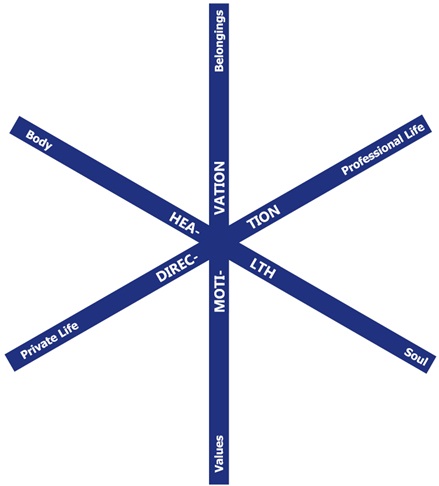 Figure 3: Areas of life
Figure 3: Areas of life
Soul
The area of life ‘Soul’ includes all aspects of mental health. This includes all areas of perception, feelings and emotions, mental health, such as a strong memory, as well as the response to experience and memories.
Drawbacks in this area of life include e.g. traumas, fears, financial worries, guilt, etc.
Body
The area of life ‘Body’ includes all aspects of physical health. These include, among others, all aspects of fitness and nutrition, body care and wellness activities as well as the healthy functioning of the body.
Drawbacks in this area of life include, e.g. obesity, tooth grinding, allergies, physical stress, etc.
Values
The area of life ‘Values’ deals with all aspects of personal attitudes. It therefore involves the individual hierarchy of values and follows-up on the question: What is important in the individuals’ life and what is stimulating him or her?
Powerful questions therefore can be: What provides you with joy? Who is important in your life? What stimulates you best?
Drawbacks in this area of life can arise through behaviours that are not consistent with the inner values of the client, such as ignoring a person he or she really loves, or to deal with things the client does not like etc.
Belongings
The area of life ‘Belongings’ includes all material objects that someone owns.
Examples include a house, a car, furniture, a wristwatch, comic collections or simply money, with which the individual can buy something in life.
Drawbacks in this area of life include debts and financial constraints, i.e. the lack of financial resources to afford things that someone would like to own.
Private Life
The area of life ‘Private Life’ includes all aspects that are outside of the professional life.
This includes, e.g. family, sports activities, hobbies, friends and all kinds of recreational activities.
Drawbacks in this area of life include, e.g. problems in the family or with friends and lack of time for the own hobby.
Professional Life
The area of life ‘Professional Life’ covers all aspects of professional development.
This includes, among others trainings, continuing education, relationships with colleagues and career opportunities.
Drawbacks in this area of life include the undesired unemployment, stagnation on the career ladder, the lack of training and an inadequate salary.
Every area of life is affected by various elements, which can be represented in the individual Life-Equilibrium Model. This creates an individual ‘map’ for each human being which enables self-reflection. Just like in a Mind Map, the elements of life are scattered around its according area of life. Figure 4 shows an example.
 Figure 4: Elements of life
Figure 4: Elements of life
The elements of life may simply represent the current area of interest of someones’ life or elements to keep focus on for his or her own development.
4.3 Two worlds: Perspectives of life
The six areas of life of the Life-Equilibrium Model can be divided into two worlds: the ‘inner world’ (perspective of how I see myself), and the ‘outside world’ (perspective of how people see me). The inner world consists of ‘Soul’, ‘Values’ and ‘Private Life’, and the outside world consists of ‘Body’, ‘Belongings’ and ‘Professional Life’.
In this context, the ‘inner world’ means that the areas totally focus on the individual whereas the ‘outside world’ is more strongly influenced by the social environment. For example, it would be easier for a person to drive a small car, as the person may consider it just being a commodity only (‘values’). However, colleagues in a company may laugh at the person as it may not be a proper status symbol. Hence, it is not uncommon that people drive a reputable limousine instead (‘belongings’). In this example, the motivational axis is imbalanced.
Although the two worlds are less important for the functioning of the Life-Equilibrium Model, they still allow an additional perspective for working with this coaching model.
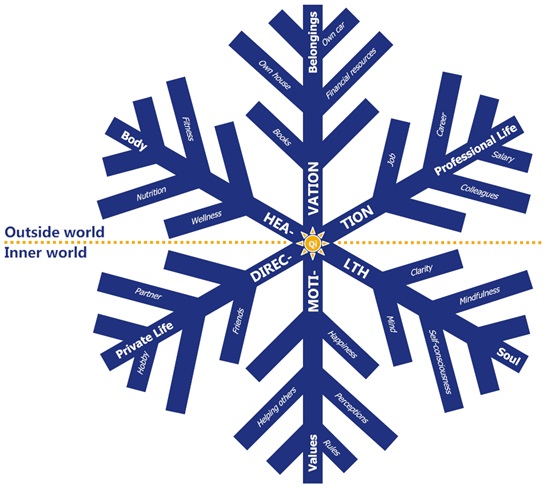 Figure 5: The Life-Equilibrium Model (LEM)
Figure 5: The Life-Equilibrium Model (LEM)
Figure 5 shows the completed Life-Equilibrium Model. In the centre of the model is a kind of sun that symbolizes the ‘solar plexus’. Inside the ‘solar plexus’, the term ‘Qi’ [Chi] is located which refers to the energy of life. This will be described further in the following chapter.
5 Coaching application
5.1 Functioning of the Life-Equilibrium Model
The operation of the Life-Equilibrium Model is described in the following chapters starting from the centre and moving towards the according areas of life. In other words, the description starts with the aim, i.e. to let the Qi flow, and moves over to the importance of the solar plexus as the gate between the conscious and subconscious mind and finally towards the work on the areas of life and its individual elements.
5.1.1 Flow of Qi as the main goal
The Chinese concept of Qi deals with the energy of life. This energy needs to flow, so that an individual can live a life in harmony.
The term ‘ Qi ‘ is, among others, known from Feng Shui, i.e. the doctrine which deals with the relationship of a human being and its environment. Thus, the own premises (apartment, furniture etc.) are arranged in a Feng Shui suitable setup to allow the Qi flow smoothly through the living environment of the individual.
Also in traditional Chinese medicine, the term Qi plays an important role where it is described as the energy of life that needs to bring harmony (e.g. acupuncture focuses on letting the energy flow through the body again).
The flow of this energy of life is vital and the Life-Equilibrium Model supports the individual to ensure this as good as possible. By creating balance in all areas of life, energy can flow smoothly and allow individuals to gain more joy and light-heartedness in life – leading into harmony.
For this reason, the Qi is at the heart of the Life-Equilibrium Model and all areas of life are intended to make the energy of life flow (see Chapter 5.1.3).
5.1.2 Conscious use of the energy of life
The Qi is surrounded by the solar plexus. The solar plexus is an autonomous network of nerve fibres in the body, i.e. a place where numerous nerves flow together. So, while the Qi is primarily perceived unconsciously and / or spiritually, the solar plexus is a real part of the body. According to the chakra doctrine, the solar plexus absorbs the energy of life and distributes it to the organs. Charles Haanel (1912), in turn, considers the solar plexus to be a kind of gateway between the conscious and subconscious mind, where conscious thoughts are transformed into unconscious behaviours.
For the purposes of the Life-Equilibrium Model the solar plexus is seen as a mix of both of the above, i.e. a central distribution point of the energy of life which can be used to consciously address subconscious behaviours. Thus, the conscious thought enables the change of unconscious behaviours and emotions – a central part of a coaching journey.
For example, the unwanted emotion of heartbreak can be consciously addressed and worked on in a coaching session to change the unconscious reaction to the heartbreak (e.g. sadness), and in turn establish a desired state. With each change of an undesirable into a desired state, an individual increases the positive energy flow and thus the Qi.
The solar plexus in the Life-Equilibrium Model is represented as a sun, as it is understood as a central distribution point of vital energy and as a gateway between the conscious acting in our areas of life, and the subconscious flow of energy, i.e. the Qi.
5.1.3 Balancing life consciously
The three components of the mechanics of life, i.e. health, motivation and direction of an individual is the first consciously perceived indication in the use of the Life-Equilibrium Model. It is necessary for individuals to treat all three components always evenly and work on them in a balanced way. This means that an individual has to pay attention to its health as well as on retaining motivation and the direction the individual embarks in life. If one of these components is permanently neglected, the Qi cannot flow smoothly, and the individual starts creating an imbalance in his or her life that will drive drawback by themselves.
The six areas of life help to keep the mechanics of life running. It is clear that an individual must work on his or her health both mentally (‘Soul’) and physically (‘Body’) – and this needs to be done also in a balanced way between the two poles to make the life energy flow smoothly.
This also applies to the other two components of the mechanics of life, i.e. motivation must come from the inside (‘Values’) and from the outside (‘Belongings’), and the individual’s direction should be based on an equal degree on privacy (Private Life) and occupation (Professional Life).
Overall, this means that all six areas of life need to be balanced to allow the Qi to flow smoothly. As a rule of thumb:
The more satisfied a person feels in an area of life, the closer it is at the centre of the Life-Equilibrium Model.
Furthermore, the following applies:
The more balanced an individual’s areas of life are, the stronger is the balance respectively harmony in his or her life.
The balance can be visualized in form of a circle in the Life-Equilibrium Model, which will be explained in Chapter 5.2.2.
Possible imbalances are due to drawbacks occurred in one or more area of life. Those can be easily visualized as elements in the individual Life-Equilibrium Model and thereby become a focus area for a coaching session.
The coaching work is performed on a conscious level. The client’s target is consciously defined and also the element the client would like to work on. Hence, the subconscious mind is often ‘just’ addressed through powerful questions to challenge the client’s thought processes. This shall, however, highlight again the importance of the solar plexus: The results of conscious work in the areas of life are transformed by the solar plexus in unconscious behaviours and feelings which shall strengthen the flow of vital energy, i.e. the Qi.
5.2 Application of the Life-Equilibrium Model
After the functionality of the Life-Equilibrium Model has been presented in the previous chapter, the coaching application of the model is explained in the following.
5.2.1 Conscious work in the areas of life
The individual areas of life have already been presented in Chapter 4. In addition, examples of possible drawbacks in the respective area of life have been provided. Such drawbacks can be addressed and worked on in a coaching environment.
It shall be noted, though, that there are additional ways to approach such drawbacks using a variety of tools and approaches in the field of (humanistic) psychology, such as hypnotherapy, Neurolinguistic Programming (NLP), positive psychology etc. The Life-Equilibrium Model is therefore a rather overarching model in which the different approaches can be applied.
When applying the Life-Equilibrium Model, a distinction between drawbacks within an area of life (i.e. its elements) and an imbalance between the poles needs to be made. Those are explained in the following.
5.2.1.1 Changes within an area of life
Drawbacks within an area of life are typical starting points for coaches when working with a client. For example, if a client is concerned about his or her job, the coach moves into the area of ‘Professional Life’ and focusses on the surrounding elements involved in this area to keep focus during the coaching session. Or, if a client does not know how he or she can afford a new car, the coach may work on an action plan to identify opportunities to achieve the goal.
 Figure 6: Working on the elements of life within areas of life
Figure 6: Working on the elements of life within areas of life
Working on changes within an area of life belong to the classical tasks and activities of a coach. It can affect and influence other areas of life and the desire of a change in one of the other areas. This is fine as long as all changes have a positive impact on the client’s life.
5.2.1.2 Changes between the areas of life
Drawbacks frequently arise in an area of life due to an imbalance between two mutually conditional areas of life, i.e. between ‘Body’ and ‘Soul’, ‘Values’ and ‘Belongings’ or ‘Private Life’ and ‘Professional Life’.
An example shall illustrate this:
A client has a small car and drives it to work every day. Colleagues find, however, that the car is too small for the position of the client and laugh about him. From time to time jokes are made about him; what the client bothers. He thinks about buying a larger car, so that colleagues respect him accordingly and thus to make the laughter stop.
The client may want to work in his area of life ‘Belongings’ to find ways to afford a larger car. From the perspective of the Life-Equilibrium Model, this would be fine as long as a large car also belongs to the value system of the client. If this is not the case, the purchase of a larger car does not increase his motivation, as it is not supported by the opposite pole of ‘Belongings’, i.e. ‘Values’. The purchase of a larger car would therefore lead to an imbalance in the
Life-Equilibrium Model along the axis of motivation. Figure 7 visualizes the situation of the client in Life-Equilibrium Model.
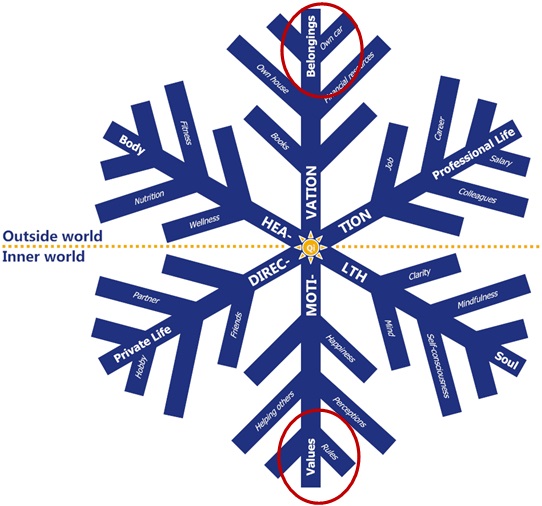 Figure 7: Working on balancing areas of life
Figure 7: Working on balancing areas of life
In order to keep the balance on motivation and to meet ‘good feelings’ in the outside world, the coach may work on both, the value system on the one hand and the action plan on belongings on the other. For instance, negative feelings about driving a small car can be addressed in coaching sessions to identify ways to address laughter by colleagues. Alternatively, the client may want to work on getting a better appreciation of a larger car.
There are no right or wrong answers and approaches in this case: it is merely the aim to strike a balance between the inner and the outside world of the client to establish harmony.
At this point it shall be mentioned that the client is often not aware that the cause of a drawback in an area of life is due to an imbalance between two mutually conditional areas of life. The Life-Equilibrium Model reminds the user of the model to always make sure to think about the balance in life and sometimes to take on a different perspective on seemingly obvious drawbacks.
5.2.2 Visualizing the degree of balance
The degree of balance in someone’s life can be visualized with the help of a so called ‘radar chart’. A radar chart is ideal for presenting results of an evaluation.
The Life-Equilibrium Model visualizes the satisfaction of the individual in the areas of life. This can be evaluated based on personal feelings, analytically by the use of a questionnaire or in the context of a coaching.
In Chapter 5.1.3 the following two rules have already been mentioned:
- “The more satisfied a person feels in an area of life, the closer it is at the centre of the Life-Equilibrium Model.”
- “The more balanced an individual’s areas of life are, the stronger is the balance respectively harmony in his or her life.”
The first rule therefore addresses the question:
How pleased am I in this area of life? Do I pay sufficient attention to my private life, or is my professional life on focus?
The satisfaction can be mapped and visualized in a scale of 0 to 100% in the radar chart.
Figure 8 shows and example.
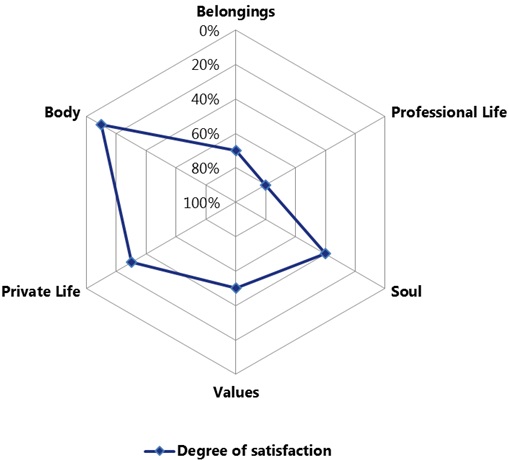 Figure 8: Example of an imbalanced life
Figure 8: Example of an imbalanced life
The example shows the results of a client’s satisfaction for each area of life. The intention of such an assessment is not so much to find the exact value in an analytical style, but rather to represent the relation of satisfaction among the areas of life. In this example, the area of life ‘Body’, i.e. the physical well-being, is furthest away from the centre and it makes sense to work on this area first. Furthermore, it seems to be that the area of ‘Professional Life’ is very satisfactory, since it is closest to the centre. This image is often seen at individuals paying full attention on the job, but neglect (due to time constraints) their body, and thereby their health.
The example shows one more thing: The client is not in equilibrium, i.e. its areas of life are not mutually balanced (second rule). A balanced life is shown in Figure 9.
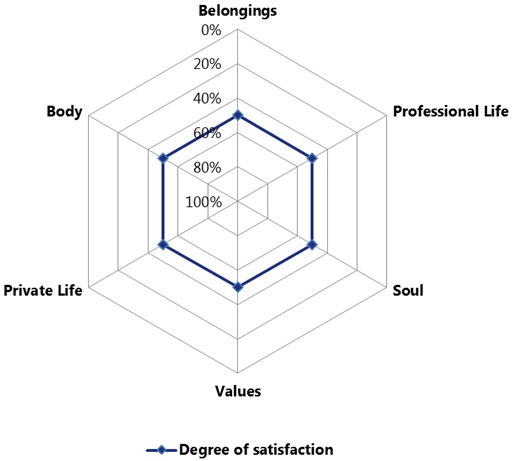 Figure 9: Example of a balanced life
Figure 9: Example of a balanced life
Figure 9 shows the level of satisfaction as a circle, i.e. the client is equally satisfied with all areas of life. For the purposes of the Life-Equilibrium Model one speaks of a Life-Equilibrium (balance in life).
Although the degree of satisfaction is not at 100 %, the life is in balance and this is what the Life-Equilibrium Model strikes for.
At this stage it needs to be mentioned, that the level of satisfaction in all areas of life will continuously change in the course of life, i.e. it will improve or deteriorate. This is fine as life continuously changes. For example, a new job may lead to a move of houses and it simply takes time until someone is settled in again.
These continuous changes ensure that individuals develop. Also a drawback on the satisfaction scale in an area of life leads to further development, because the individual learns to overcome such drawback. This drives experience.
This again illustrates why the Life-Equilibrium Model can be seen as a constant companion in the life of every individual.
5.2.3 Forms of application
5.2.3.1 Guidance
Chapter 1 has already explained that the Life-Equilibrium Model can also be used purely as a guide for coaching sessions. The visual orientation helps the client to make the problem tangible and thereby contributes to the identification of objectives. The client can thus represent his or her own Life-Equilibrium Model individually.
5.2.3.2 Trigger for imbalances
In daily life, the Life-Equilibrium Model supports individuals to always think about its own balance in life. The symbol of a snowflake helps the individual here.
It is also possible to visually represent the status of someone’s own balance for themselves. For this purpose, it is sufficient to quickly mark the degrees of satisfaction in the individual
Life-Equilibrium Model. Developing an analytical radar chart is not necessary for regular approaches. Figure 10 illustrates an example.
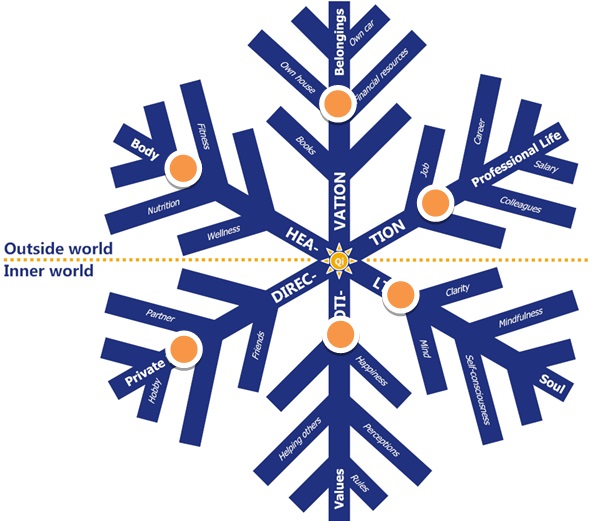 Figure 10: Quick visualization of someone’s own equilibrium
Figure 10: Quick visualization of someone’s own equilibrium
Due to the quick visualization of someone’s own equilibrium, the individual creates an awareness on where action is required to overcome potential drawbacks. The coach is thereby a helpful resource.
References
Archer, Jeff (2006), “Life Coach“, McGraw-Hill, Whitby.
Haanel, Charles F. (1912), „Das Master Key System“, Übersetzung durch Helmar Rudolph & Franz Glanz (2007), Fuegen.
Reiland, Christian (2008), “LOA – Das Gesetz der Anziehung”, Wilhelm Goldmann Verlag, Munich.
Robbins, Anthony (2009), “Find Your Balance”, Available at: http://www.tonyrobbins.com/Home/Home.aspx [Accessed 07 September 2009].
Tiki Küstenmacher, Werner, Seiwert, Lothar J. (2008), “Simplify your Life – Einfacher und glücklicher leben“, Th. Knaur, Munich.